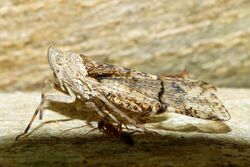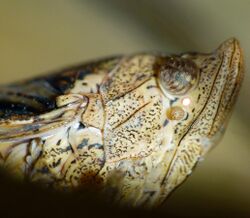Biology:Dichoptera
From HandWiki
Revision as of 03:22, 11 August 2022 by imported>John Stpola (over-write)
Short description: Genus of planthoppers
| Dichoptera | |
|---|---|

| |
| Dichoptera hyalinata | |
| Scientific classification | |
| Domain: | Eukaryota |
| Kingdom: | Animalia |
| Phylum: | Arthropoda |
| Class: | Insecta |
| Order: | Hemiptera |
| Suborder: | Auchenorrhyncha |
| Infraorder: | Fulgoromorpha |
| Family: | Fulgoridae |
| Subfamily: | Dichopterinae |
| Genus: | Dichoptera Spinola, 1839 |
| Type species | |
| Dichoptera hyalinata (Fabricius, 1781)
| |
| Species | |
| |
Dichoptera is a genus of planthoppers found in tropical Asia. They were formerly placed in the family Dictyopharidae but are now considered members of the family Fulgoridae.[1]
They have large and stout bodies with long membranous forewings. The head is short and may have a long process. There are 11 species in the genus.[2][3]
Often found on the bark of Ficus trees, they are tended by ants and sometimes parasitized by Dryinidae.[4]
References
- ↑ Emeljanov A (1979) The problem of differentiation of the families Fulgoridae and Dictyopharidae. Trudy Zoologicheskogo Instituta Akademii Nauk SSSR 82:3-22.
- ↑ Song, Z; Bourgoin, T; Liang, A (2011). "Review of the Oriental Monotypic Genus Pibrocha Kirkaldy (Hemiptera, Fulgoromorpha, Fulgoridae, Dorysarthrinae)". ZooKeys (132): 1–13. doi:10.3897/zookeys.132.1319. PMID 22140330.
- ↑ Distant, W.L. (1906). Fauna of British India, including Ceylon and Burma. Rhynchota. Volume III.. London: Taylor and Francis. pp. 237–240. https://archive.org/stream/rhynchota03dist#page/236/mode/2up/.
- ↑ Swaminathan, S. & T.N. Ananthakrishnan (1984). "Population trends of some monophagous and polyphagous fulgoroides in relation to biotic and abiotic factors (Insecta: Homoptera)". Proceedings: Animal Sciences 93 (1): 1–8. doi:10.1007/bf03186220. https://archive.org/stream/proceedingsofthe020233mbp#page/n5/mode/1up.
Wikidata ☰ Q10471309 entry
 |


